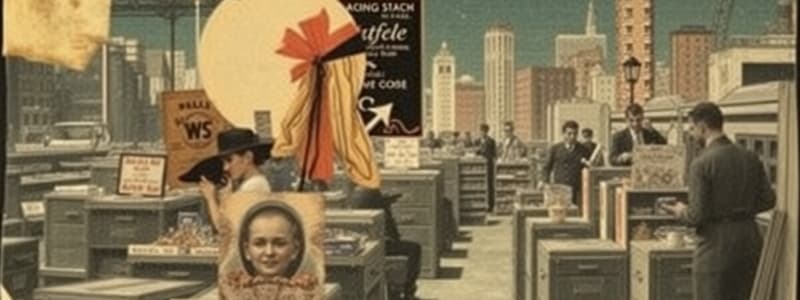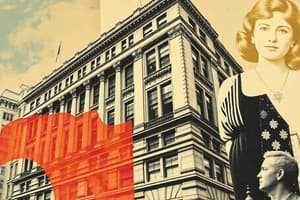Podcast
Questions and Answers
What characterized the economic conditions of the 1920s?
What characterized the economic conditions of the 1920s?
- Widespread unemployment and deflation
- Economic recovery following a global crisis
- Strong prosperity and consumer confidence (correct)
- Strict government regulation of markets
How did the Great Depression impact economic policy moving forward?
How did the Great Depression impact economic policy moving forward?
- It led to a complete withdrawal of government intervention in the economy.
- It prompted a shift towards more proactive government intervention in economic crises. (correct)
- It had no significant effect on future economic policies.
- It resulted in a stronger focus on laissez-faire economic principles.
What was one of the risks highlighted by the economic fluctuations of the 1920s and 1930s?
What was one of the risks highlighted by the economic fluctuations of the 1920s and 1930s?
- The effectiveness of minimal regulation
- The necessity of high government debt levels
- The resilience of economic systems in crisis
- The dangers of unchecked speculation (correct)
What was a key lesson learned from the economic transition from the 1920s to the 1930s?
What was a key lesson learned from the economic transition from the 1920s to the 1930s?
What did the contrasting environments of the 1920s and 1930s demonstrate about economic policies?
What did the contrasting environments of the 1920s and 1930s demonstrate about economic policies?
What primarily drove the economic growth in the United States during the 1920s?
What primarily drove the economic growth in the United States during the 1920s?
Which innovation greatly contributed to consumer demand in the 1920s?
Which innovation greatly contributed to consumer demand in the 1920s?
What financial practice became increasingly popular in the 1920s and contributed to economic growth?
What financial practice became increasingly popular in the 1920s and contributed to economic growth?
What event is widely regarded as the beginning of the Great Depression?
What event is widely regarded as the beginning of the Great Depression?
What was a major consequence of the stock market crash in 1929?
What was a major consequence of the stock market crash in 1929?
During the Great Depression, what was the initial government response to the economic crisis?
During the Great Depression, what was the initial government response to the economic crisis?
What characterized the economic situation in agriculture during the Roaring Twenties?
What characterized the economic situation in agriculture during the Roaring Twenties?
What role did government intervention play during the Great Depression?
What role did government intervention play during the Great Depression?
Flashcards
Great Depression impact
Great Depression impact
The Great Depression significantly altered economic policy, social structures, and political systems globally.
1920s vs. 1930s economy
1920s vs. 1930s economy
The 1920s were prosperous, while the 1930s were marked by the Great Depression, showcasing economic cycles.
Economic Policies for Crisis
Economic Policies for Crisis
During economic crises like the Great Depression, robust economic policies are vital to prevent future disasters and recover.
Fragile Economic Systems
Fragile Economic Systems
Signup and view all the flashcards
Economic Thought Reshaped
Economic Thought Reshaped
Signup and view all the flashcards
Roaring Twenties Economic Growth
Roaring Twenties Economic Growth
Signup and view all the flashcards
Mass Production
Mass Production
Signup and view all the flashcards
Consumer Credit
Consumer Credit
Signup and view all the flashcards
Stock Market Crash of 1929
Stock Market Crash of 1929
Signup and view all the flashcards
Great Depression
Great Depression
Signup and view all the flashcards
Bank Failures
Bank Failures
Signup and view all the flashcards
Laissez-faire economics
Laissez-faire economics
Signup and view all the flashcards
Government Intervention (Depression)
Government Intervention (Depression)
Signup and view all the flashcards
Study Notes
Roaring Twenties Economic Changes
- The 1920s saw significant economic growth in the United States, driven by technological advancements, mass production, and consumerism.
- Innovations like the automobile and the radio spurred demand and fueled economic expansion.
- Mass production techniques, pioneered by companies like Ford, dramatically lowered the cost of goods, making them more accessible to the average consumer.
- Consumer credit became increasingly popular, allowing individuals to purchase goods they might not otherwise afford, further boosting the economy.
- The availability of credit and installment plans fuelled a spending spree, contributing to a period of prosperity and optimism.
- Stock market speculation became rampant, with investors pouring money into the market, hoping to profit from rising share prices.
- This speculative bubble was characterized by high levels of investment and borrowing, which became a key element leading to the next economic downturn.
- While the economy thrived for many, significant income inequality existed, with wealth concentrated among a smaller percentage of the population.
- Agriculture faced significant challenges during this period, struggling with fluctuating prices and the impacts of new technologies and increased competition.
Great Depression Economic Changes
- The Great Depression, beginning in 1929, was a severe worldwide economic downturn.
- The stock market crash of October 1929 marked the beginning of the decade-long depression.
- This event triggered a series of interconnected economic failures.
- Banks failed as customers withdrew their deposits, leading to a widespread loss of savings and confidence in the financial system.
- Reduced consumer spending and investment led to business closures and widespread unemployment.
- The global nature of the economy meant the crisis spread rapidly, impacting countries across the world.
- Reduced trade and international investment were further consequences of the widespread fear and panic.
- The Depression was characterized by high unemployment rates, widespread poverty, and social unrest.
- Governments around the world struggled to respond effectively to the crisis, initially adopting policies of laissez-faire economics.
- The eventual implementation of government intervention and programs to stimulate demand and provide relief played a critical role in mitigating some of the crisis's worse effects, although a complete recovery took several years.
- The Depression profoundly impacted societies across the globe, leaving lasting effects on economic policy, social structures, and political systems.
- The effects of the Depression and the methods used to recover from it significantly changed economic thought and policy moving forward.
Contrasting Economic Environments
- The 1920s and the 1930s presented vastly different economic conditions, with the "Roaring Twenties" characterized by prosperity contrasted sharply against the widespread suffering during the Great Depression.
- These contrasting environments highlight the cyclical nature of economic fluctuations and the importance of robust economic policies that can withstand major economic shocks.
- The period demonstrates the risks of unchecked speculation and the importance of effective government intervention during economic crises.
- The shift from prosperity to despair underscored the fragility of economic systems and the need for proactive measures to prevent future economic disasters.
- The economic theories and policies employed in response to each, particularly in the case of the Depression, significantly reshaped economic thought and policy for decades thereafter.
Studying That Suits You
Use AI to generate personalized quizzes and flashcards to suit your learning preferences.




